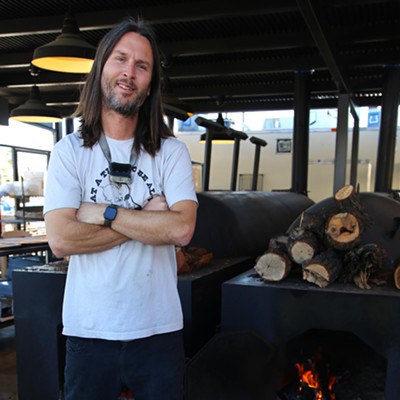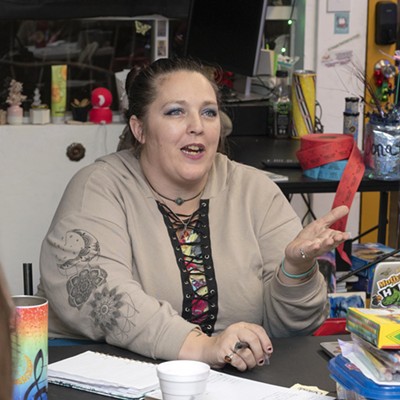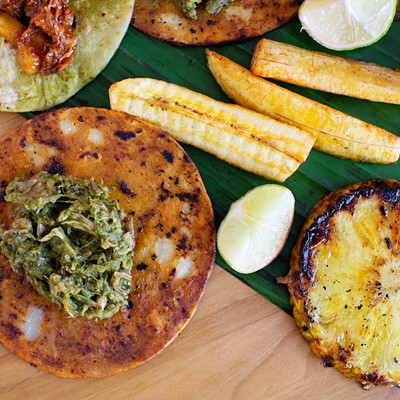IN OUR CULTURE of convenience, it is easy to be lulled into a sense of complacency when it comes to all things: dining, cooking, giving gifts. Recently, as I was browsing in a bookstore I stumbled across two books called, and I jest not, Wine for Dummies and Food for Dummies. Indeed. Clearly, it would be excruciating to be the recipient of such a gift. Still, pity the givers. Not only have they exposed their sheer desperation and appalling lack of good taste, they just missed the treasure trove of the effortless gift: the cookbook.
A good cookbook covers all possible motives for gift giving, from "I love you, please learn how to cook" to "You are a marvelous cook, please learn something new" to "You are a god, please cook this for me." The recipients can interpret the gesture in any way they choose, but we all know that a really good cookbook should be a highly charged, sensual experience. Good food writing hovers on the plane of the finest writing: There is the search for beauty, the perfectly distilled moment, the drama of preparation, culinary vision, and, of course, dessert.
I've read worse best sellers.
Long after the tinsel has been tossed and the chia plant fried in the window, cookbooks will still find a way to remind the ones you love that you believe in their ability to do one of the most elemental of all things: to nurture and nourish. Maybe they'll even give you really good things to eat.
Hot Sour Salty Sweet: A Culinary Journey through Southeast Asia, by Jeffrey Alford and Naomi Duguid; Artisan, $40.
Occasionally a cookbook comes along that is so breathtakingly beautiful you want to just own it for yourself. Oh, you might buy it with the intention of giving it to someone you dearly love, but somehow, even wrapped, it whispers your name and never quite makes it under the tree. This is one such book, and you'd do well to buy more than one copy.
Alford and Duguid's first book, Flatbreads and Flavors: A Baker's Atlas, was named James Beard Cookbook of the Year and won the IACP/Julia Child Best First Book Award. Alford and Duguid are a married couple traveling the world as nomads, fusing travel narrative with recipes, anecdote with technique. Their books are stunningly beautiful, illustrated by their own photography. This book uses their most recent journey down the Mekong River as the thread to seam their narrative together. Avoiding the too-traveled high road, these two nomads prefer to meander through South Asia's small villages to watch how the household fish pond works or how to make noodles by hand. A wonderful blend of geography, travel narrative, cultural documentation, odd musings, recipes that actually work, and outstanding photography makes this book a keeper. If I could only buy one cookbook this year, without doubt this would be it. And I'd keep it.
How to Cook Meat, by Chris Schelsinger and John Willoughby; HarperCollins, $35.
Be not lulled by this simple title. Schlesinger and Willoughby, the bad boys of culinaria, titillated and delighted with their earlier award-winning books, Thrill of the Grill and License to Grill. Here those incorrigibles rock out with an incredibly exhaustive monument to meat. With an extensive introduction to identifying cuts of meat and the methods for cooking, the book wittily organizes chapters by cuts ("Veal: Guess Who's Coming to Dinner?"; "Pork: Swine of the Times") and even spends time on how to make cheaper cuts taste great.
Dedicated to fire and coaxing out big, juicy tastes, this book is a win for the carnivore you love. If Cumin Crusted Chateaubriand with Wild Mushrooms and Madeira or Roasted Rack of Lamb with Grilled Peaches make your eyes glaze over, then reach for the wallet. This is one hip barbecue and butcher's bible for anyone in your life who unabashedly loves flesh.
Essential Cuisines of Mexico, by Diana Kennedy; Random House, $35.
Even if the one you love has every single one of Diana Kennedy's cookbooks, this is still an edition not to be missed. And you'll be in luck if you know someone who isn't familiar with the grande dame's previous classics. This updated compilation of The Cuisines of Mexico, Mexican Regional Cooking and The Tortilla Book takes a good thing and makes it better. With her acerbic wit and eye for the overlooked detail, Kennedy has kept the best of her narratives and recipes, and updated some of the classics, adding a few new recipes along the way.
Listing over 22 salsas, and innumerable ways to cook with masa, chiles and meats in every possible regional variation, this book is worth purchasing as a definitive reference. Small jewels like the charming story of Caldo de Piedra (broth of stones) remind us again how and why Kennedy has distinguished herself as a cut above other food writers. Her quiet ability to penetrate and find human truth in the simplest of moments or motions has earmarked her work as superior from her very first book. How lucky to find all her work polished up and in one expansive collection.
Pot on the Fire: Further Exploits of a Renegade Cook, by John Thorne; North Point Press, FSG, $25.
If you haven't yet discovered the eccentric and mesmerizing voice of John Thorne you're in for a rare find. Arriving on the scene with his award-winning Outlaw Cook (IACP/Julia Child Award) and Serious Pig, Thorne won readers over with his remarkably unpretentious approach to food. His back-to-basics approach is balanced with philosophical musings, wry reminiscences and lyrical meditations on the simplest of household procedures. With this part memoir, part cookbook, Thorne is bent on demystifying "Cuisine" as only the property of professionals or the rich. His chapters "Desperately Resisting Risotto" or "Quintessential Toast" are by turns amusing and informative; his final chapter, "Last Gleaning," breaks your heart in just the right way. No flash, no glossy photographs, no celebrity chefs; these quiet musings are the pure, real thing. A highly recommended read.
Noodle, by Terry Durack; SOMA, $27.
"To witness the birth of a noodle is a beautiful thing." So Durack, Australia's most influential food critic, confides to us in this sleek and beautifully illustrated book devoted to the art of cooking noodles. Designed for those eternally baffled by the many different forms noodles take in Asian cuisine, this book gives plenty of accessible information on 20 types of noodles before navigating the trickier waters of preparation.
Recipes are grouped by country and thoroughly represent the Orient. If you can't tell your dang myun from your udon, then the user-friendly noodle ID inset at the bottom of every page will visually assist even the most noodle-challenged. The recipes are straightforward and easy to prepare. Many dishes are as pleasing to the ear as to the tongue: Moon Viewing Noodles, Spring Rain Tempura and Long Life will leave you slurpy and happy.
In his breezy, informative fashion, Durack doesn't chat the reader up any more than necessary. He clearly believes that noodles are essential for human survival, and charmingly convinces us of the same.
The Modern Vegetarian Kitchen, by Peter Berley; Regan Books, $35.
After all the high holiday indulgence, this book's simple approach will probably be sheer relief. A high-minded, unapologetic vegetarian/macrobiotic/ vegan tome, this book makes you feel healthy just paging through it. Berley's approach isn't strictly militant; he's not afraid to throw in a few eggs or cheese on occasion to preserve the integrity of the dish. Somehow, this lends him considerable credibility.
Vegetarian cuisine is often perceived as the cuisine of frugality, yet Berley reveals page upon page of rich, vital dishes. Organizing the book by varying food groups, and in some instances by the seasons, Berley quietly takes his time to present a practical approach to a healthful lifestyle. His Pumpkin-Chestnut Soup and extensive bread chapter, particularly the focus on flatbreads, will cheer up and sustain even the most pinched, Grinchy veg-head in your life.








